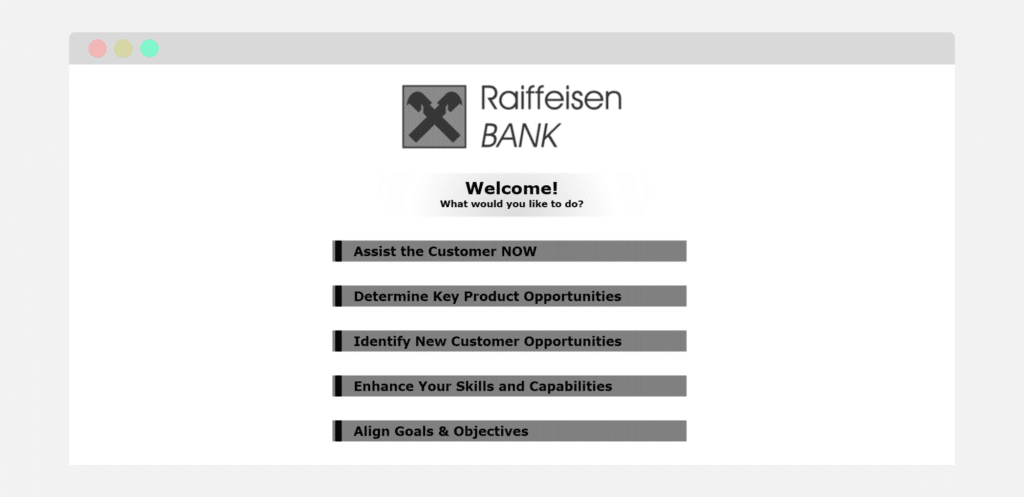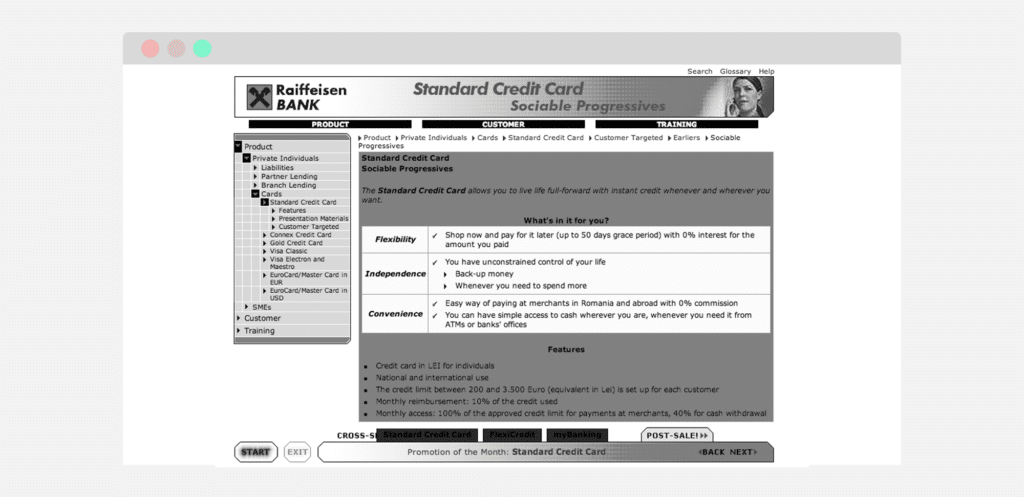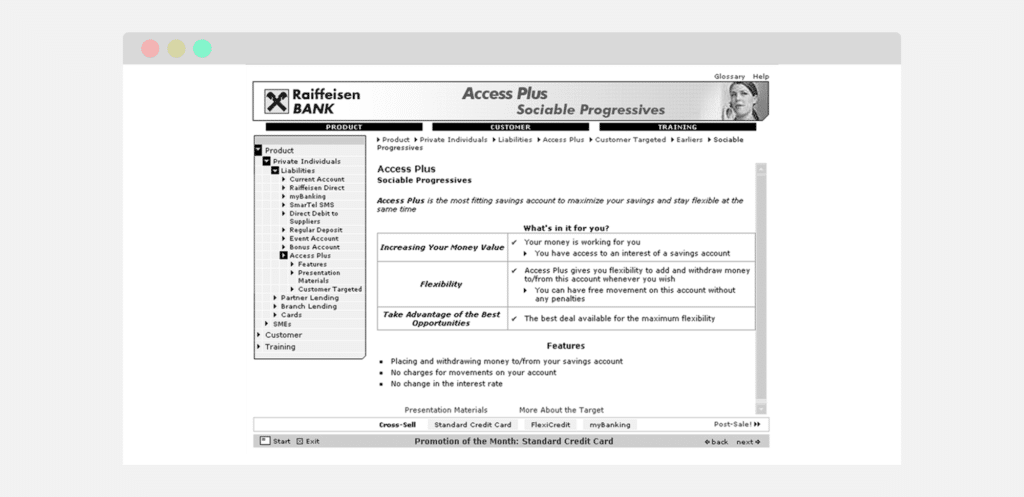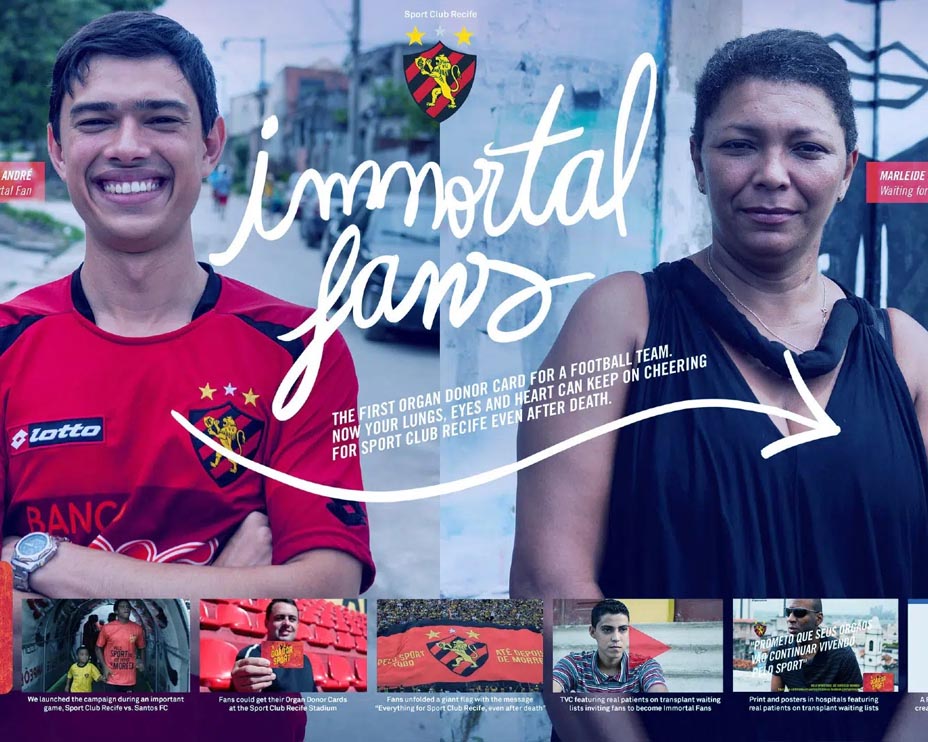Raiffeisen Bank, the large European financial group, has had a very rapid rise to the third position in the Romanian market in just over four years. The acquisition of the Romanian state-owned Banca Agricola network of over 220 banking outlets throughout the country and an employee headcount of over 4,000 people gained Raiffeisen an almost immediate presence in the market. But with it came a massive integration challenge.
The first steps in the integration were establishing operating standards in line with what the Vienna-based bank expected from its operations in 15 Central and Eastern European (CEE) countries. Almost simultaneously was a physical makeover that created the most customer-friendly banking environment Romanians have ever experienced. Into this came a young marketing director who immediately went to work upgrading the marketing standards, not only relative to Western banking levels, but to the higher level they believed banks should be operating everywhere – a financial institution where marketing and creating customer value becomes everyone’s job.

 But if they still feel they need to sell this product to a customer target segment other than the Priority Customer Target, they can click Other Customer Targets link and choose from the list of all other customer target segments so that they can learn how they can communicate the benefits of the product to another customer target segment that they find necessary.
The Presentation Materials link leads the sales staff to a page that provides links to all the presentation materials that they might need for this product.
But if they still feel they need to sell this product to a customer target segment other than the Priority Customer Target, they can click Other Customer Targets link and choose from the list of all other customer target segments so that they can learn how they can communicate the benefits of the product to another customer target segment that they find necessary.
The Presentation Materials link leads the sales staff to a page that provides links to all the presentation materials that they might need for this product.

 In order to determine this, they can open the toolbox and click Identify New Customer Opportunities from the Start page. They can then navigate through the customer groups to the page of this customer segment.
On this customer segment page, they can find a short description of the customer to quickly capture a few key insights. If they’d like to get a deeper understanding, they can click on the Detailed Description link and find all details of their demographics, attitudes, values, hopes, and aspirations, as well as lifestyle.
But if they feel they know the target pretty well already from previous experience with the toolbox relative to that customer segment, they can directly choose one of the Recommended Products to source product information that best fits this customer’s needs, wants, and lifestyle. The salesperson can then go to the Customer/Product-Specific page to determine the best manner of selling this product to that customer. Or furthermore, they can choose any other product that they think is appropriate to sell to this customer based on the information easily at hand in the toolbox.
In order to determine this, they can open the toolbox and click Identify New Customer Opportunities from the Start page. They can then navigate through the customer groups to the page of this customer segment.
On this customer segment page, they can find a short description of the customer to quickly capture a few key insights. If they’d like to get a deeper understanding, they can click on the Detailed Description link and find all details of their demographics, attitudes, values, hopes, and aspirations, as well as lifestyle.
But if they feel they know the target pretty well already from previous experience with the toolbox relative to that customer segment, they can directly choose one of the Recommended Products to source product information that best fits this customer’s needs, wants, and lifestyle. The salesperson can then go to the Customer/Product-Specific page to determine the best manner of selling this product to that customer. Or furthermore, they can choose any other product that they think is appropriate to sell to this customer based on the information easily at hand in the toolbox.

“All the purchase intent in the world doesn’t create any real value to the bank unless it’s transformed into actual purchase behavior.”
After completing an exhaustive customer segmentation and insight mining process, the Romanian marketing director felt his small group of marketers located in the bank’s headquarters in Bucharest understood the pulse of the customer. His team then went about the process of developing brand architectures targeting over 30 different banking products to 22 specific customer segments. They briefed agencies and developed communication materials that connected emotionally and functionally to the customers as they moved through their daily lives outside the walls of the bank with targeted messages for Raiffeisen credit cards, consumer loans, and a range of savings products – just to name of few of the areas they attacked as a result of their enhanced knowledge of the customer base in Romania. But beyond some posters and brochures inside the 220-branch network, most of the impact the team had was on driving purchase intent outside the bank itself. However, all the purchase intent in the world doesn’t create any real value to the bank unless it’s transformed into actual purchase behavior. For that, the marketing guys needed the participation of all the people in daily contact with customers across the entire country. Rather than fight to increase his control of what happens with customers inside the bank – a classic battle pitching his marketing department against the sales department that is currently underway in many banks – the Romanian Raiffeisen marketing team went the other way. Armed with customer information and insights that could be extremely beneficial to everyone from frontline salespeople in the banks all the way to key account managers calling on Small and Medium Enterprises (SMEs), the team looked for a ‘lead and influence’ mechanism to get that customer knowledge out to as many people throughout the network – all 4,000 employees if possible. The question quickly became: “What’s possible?”The problem
Customizing product benefits and messages to specific customer segments in the bank may sound like a good idea, but making it happen is something else. How do you identify different customers on-site in over 400 bank locations across Romania? How do you make different customer needs clear and actionable? Also, how do you get the right tools to the frontline salespeople at any given moment? What are the best cross-sell opportunities for a particular customer type? In other words, how can you make every sales officer at every outlet a marketing person? How do you transfer your knowledge and make sure that they know all the customer segments so thoroughly that they can determine what customer is sitting in front of them at any given moment, and what benefits of which banking products should be communicated to that specific customer? How can the marketing department in Bucharest help bank employees across 220 locations sell more banking products “to more people, for more money, more often”, and – don’t forget – “more efficiently”? The tried-and-not-so-true solution was to spend considerable money, time, and resources training salespeople to improve customer service. But then, even after the training you still cannot be sure that they will use what they learned and will not fall into the usual way of doing things because of time pressure or just complacency. The salesforce was already suffering from information overload, so piling on more books and more training was probably not the best means to the ‘lead and influence’ situation the marketing team was intent on creating.The solution
If you want to turn everyone into a marketing guy, one of the first things you must do is to give them the tools to accomplish the job. Thus, the Raiffeisen Marketing Toolbox was born. The toolbox was designed by the marketing department to assist the sales force, primarily the Front Desk Officers, in their everyday tasks – that is, selling value-added products to customers. The toolbox is driven by a software application that guides and arms the Raiffeisen sales force with the customer knowledge linked to the right product with the right sales message. The software was developed to support them during the entire selling process – from determining what kind of customer is sitting in front of them at that moment, to providing the product descriptions and sales materials targeted to that specific customer. It also offers the salesperson the products with the best potential for cross-selling, thereby facilitating an important post-sale element.Raiffeisen Marketing Toolbox: Built-in flexibility
The frontline people can approach the sales situation from two ways – from the perspective of selling to a specific customer and then accessing the appropriate product data (the customer block), or from the position of wanting to sell a specific product and wanting to figure out who are the best customers to go after (the product block). The toolbox is a multidimensional tool that can support the sale of a specific product, or can help when the salesperson needs to sell more to a specific customer segment. Also included is a knowledge database that provides them with a wide range of support materials from self-training to branch decoration standards. For the users, the toolbox looks like a website. They open it with Internet Explorer and navigate it in a normal way that they all use to navigate on the Internet.
Raiffeisen Marketing Toolbox: Product block
In a bank – just as in most other businesses – the sales force typically has objectives to sell more of a specific product over a given period. How should they sell it, to whom they should they sell it, and which sales tools they should use are the key questions. The toolbox supports this task right from the Start page. The salesperson can click on Determine Key Product Opportunities and then select the product they need to sell. The first thing they see is a general Product Description. Although the description is not yet targeted to any of the customer segments, it still goes a step forward – from the business as usual way of describing only the features of the banking product, to communicating the key functional and emotional benefits from the product’s Brand Architecture. Thus, from the very beginning, the sales force is already moving beyond the usual pure product features-driven sales, and into the benefits that the product can provide to the customer.Priority Customer Target
The next level of customization is in clicking Priority Customer Target. A Priority Customer Target is one of the segments that the Raiffeisen team determined from in-depth research to be the communication focus for this specific product. This is the target segment that the salespeople should understand better in order to sell more. When they click on the link, they get to a page with deeper insight into customer needs – the key benefits and even the copywriting of the description is closely tied to the psychographics of the customer so that they can think and feel that this is a product for them with a focused proposition on how this product can make their life better. This customer/product-specific page tells the sales force what they need to communicate in order to sell this product. It also contains a link to the full description of the customer segment to give quick access to an even deeper understanding if so desired by the salesperson. Presentation Materials designed specifically for this customer target go to the next step of arming the sales force with the communication tools needed to close the sale (leaflets, brochures, presentations, etc.). There they can open the files and choose materials that would be the best for their particular situation. But if they still feel they need to sell this product to a customer target segment other than the Priority Customer Target, they can click Other Customer Targets link and choose from the list of all other customer target segments so that they can learn how they can communicate the benefits of the product to another customer target segment that they find necessary.
The Presentation Materials link leads the sales staff to a page that provides links to all the presentation materials that they might need for this product.
But if they still feel they need to sell this product to a customer target segment other than the Priority Customer Target, they can click Other Customer Targets link and choose from the list of all other customer target segments so that they can learn how they can communicate the benefits of the product to another customer target segment that they find necessary.
The Presentation Materials link leads the sales staff to a page that provides links to all the presentation materials that they might need for this product.

Raiffeisen Marketing Toolbox: Customer block
One of the tasks of the sales force is to sell more banking products to a specific customer segment at the point where they encounter that customer. For example, depending on the location of their branch, some of the customers that come in may be from the segment SOCIAL PROGRESSIVES. The toolbox can help the sales force determine which products they should sell to that type of customer and which sales materials they should use. In order to determine this, they can open the toolbox and click Identify New Customer Opportunities from the Start page. They can then navigate through the customer groups to the page of this customer segment.
On this customer segment page, they can find a short description of the customer to quickly capture a few key insights. If they’d like to get a deeper understanding, they can click on the Detailed Description link and find all details of their demographics, attitudes, values, hopes, and aspirations, as well as lifestyle.
But if they feel they know the target pretty well already from previous experience with the toolbox relative to that customer segment, they can directly choose one of the Recommended Products to source product information that best fits this customer’s needs, wants, and lifestyle. The salesperson can then go to the Customer/Product-Specific page to determine the best manner of selling this product to that customer. Or furthermore, they can choose any other product that they think is appropriate to sell to this customer based on the information easily at hand in the toolbox.
In order to determine this, they can open the toolbox and click Identify New Customer Opportunities from the Start page. They can then navigate through the customer groups to the page of this customer segment.
On this customer segment page, they can find a short description of the customer to quickly capture a few key insights. If they’d like to get a deeper understanding, they can click on the Detailed Description link and find all details of their demographics, attitudes, values, hopes, and aspirations, as well as lifestyle.
But if they feel they know the target pretty well already from previous experience with the toolbox relative to that customer segment, they can directly choose one of the Recommended Products to source product information that best fits this customer’s needs, wants, and lifestyle. The salesperson can then go to the Customer/Product-Specific page to determine the best manner of selling this product to that customer. Or furthermore, they can choose any other product that they think is appropriate to sell to this customer based on the information easily at hand in the toolbox.
Raiffeisen Marketing Toolbox: Assisting the customer now
Another situation when the sales force needs to sell products to the customer is at a Raiffeisen branch when the customer is already sitting in front of the Front Desk Officer. A situation with intense time pressure – the customers don’t have much patience, and will not tolerate waiting in line for long. The salesperson can use the toolbox to quickly identify what customer type is sitting in front of them, and proceed accordingly. The toolbox allows the salesperson to do that with a quick questionnaire. They’d first get permission from the customer to take a couple of minutes to quickly learn more about them with a few carefully chosen questions that identify the customer as belonging to a specific segment. A few clicks through the questions and the toolbox redirects the salesperson directly to the page for the customer type sitting a meter away.Raiffeisen Marketing Toolbox: Supporting tools
An important task for the banking salesforce is to cross-sell other banking products to the customer. Prior to the toolbox, cross-selling success would depend on the Front Desk Officer’s knowledge of the customers and all the banking products, and ability to understand which products are more likely to be sold to this customer – a lot to ask a salesperson when over 30 products are available and more become available each month. Consequently, cross-selling is very hard to support. In the toolbox, from every customer-specific page, the salesperson has direct access to the cross-selling products that are most likely to appeal to the customer target they are currently dealing with. This makes it easy at any point of the selling process to offer the customer other products that they might also need, and to describe these products in the best possible way to close another sale. Promotions of the month also had the same approach. This bar always stays at the bottom of the toolbox as a constant reminder for the sales force about this month’s promotion and leads to the description of the product, its features, and benefits, and the essence of promotion – a Why not now? call to action. After the Front Desk Officer has profiled the customer, sold them the products they wanted, and cross-sold them the products they also needed, they should not forget about the post-sale phase of any selling process. The toolbox closes the loop by suggesting what to say to the customer after the contract has been signed and inviting the customer to contact them with any questions that may arise. It also gives the salesforce the possibility to send an email to the back office in case there’s a need to contact the customer with more information on their finances and banking products.



